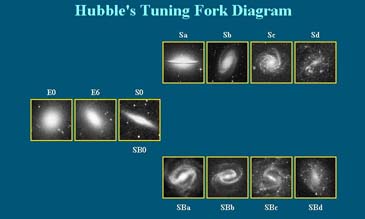
GALAXIES
THEIR STRUCTURES, AND EVOLUTION
In the previous issue of our wall magazine we talked about various stars and planets. Now we would like to integrate our knowledge to study galaxy as a whole. In this article, we will discuss something about appearance and types of galaxies as classified by Hubble.
The very first question that comes in the mind is that whether all these galaxies are same or there is some difference among them? How do they differ and what are their underlying similarities?
Letís confront ourselves with their similarities first: -
You may regard a Galaxy as an island of stars. At first site, all of them appear as a hazy patch in sky but as you focus your vision you will discover that they have some characteristic geometry. Differences do lie in their appearances. Out of 2000 observed galaxies only 3% have no symmetry so they are called "Irregular" type of galaxies. The rest are either elliptical called ELLIPTICAL GALAXIES or spirals called SPIRAL GALAXIES. Former type is less abundant only 20% and the latter ones occupy most of the list i.e.77%.
Hubble first suggested this classification of galaxies. This can be put very aptly in a diagram known as hubble tuning fork.

Irregular Galaxy: -
As already pointed out these type don't have any symmetry. They are very few in numbers. The nearest to us, belonging to this type is known as the Large Magllenic cloud (LMC) and the Small Magllenic cloud (SMC). These are the most celebrated of its kind. Other well known includes M82 and NGC5192. LMC and SMC are important for studying irregular galaxies in details and observing star evolution in these galaxies. Unfortunately, it is not visible from mid-northern latitudes. Whenever if you ever have a chance to go Madras or any other southern place, don't forget to gaze at it!
Elliptical Galaxy: -
These are quite abundant in our universe. Out of observed galaxies, 20% are of this type. These galaxies are beautifully symmetric but featureless. Since an ellipse has eccentricity as one of its parameters, one parameter is needed to say more precisely about what type of elliptic the galaxy is. For astronomical uses term ellipticity is used to do so, which is defined as
10*(1-b/a)
where a is semimajor axis and b is semiminor axis of the ellipse we are considering (i.e. the galaxy).
For e.g. Galaxy having semimajor and semiminor axes as 10' and 5' is E5 as
10(1-5/10) = 5
Thus a galaxy appearing circular need not be a circle it may be elliptical. Most flattened one is E7. Regular galaxies flatter than this are all spirals. Celebrated elliptic galaxies are M87 (Virgo), NGC205 (the satellite galaxy of andromeda).
Spirals Galaxy: -
Most bright galaxies are Spirals. The type is divided in two major categories.
1.Normal Spirals (designated as S)
2.Barred spirals (designated as SB)
NORMAL SPIRAL
The normal type can be arranged in a sequence determined by how tightly the arms are wound and the extent to which stars and nebulae can be resolved. The loosest coiling is in type Sc and tightest is of type Sa.
Some of the celebrated normal spirals are M51(Whirlpool galaxy : Sc) & M31(Andromeda galaxy : Sb)
BARRED SPIRAL
Minorities of spirals have a bright bar that slices across the nucleus. Similar characterization can be given to barred spiral depending upon the tightness of the spiral arms. A celebrated one is NGC1300 in Eridanus.
This is not the only classification scheme. There are many but this is the most basic and quite adequate for any amateurs work. But it is not that good for an astrophysicistís work. The reason being that this classification is morphological rather than physical. It is quite likely that an E7 type can be misinterpreted as E0 etc.
In the next part of the article we will discuss relation of
hubble tuning fork with galaxy evolution.
References: -